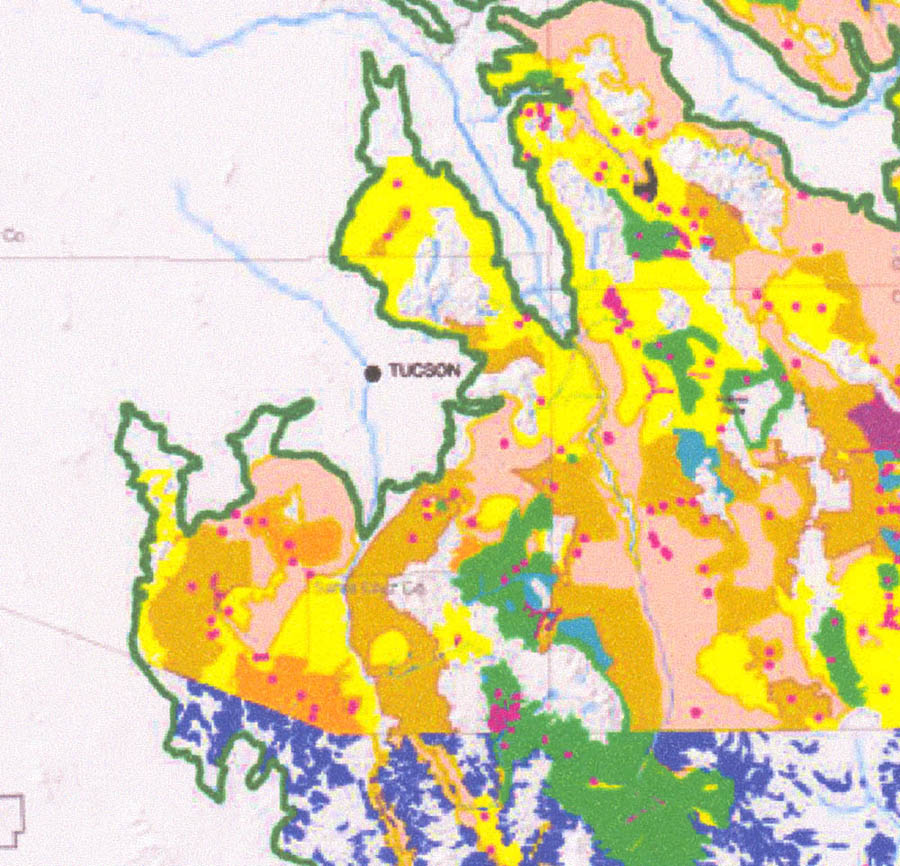Above, Apache Highlands grasslands on bajada slopes below the northwestern flanks of the Whetstone Mountains, August 31, 2008.
Apache Highlands Grasslands
Main Source: Gori, D.F., and C.A.F. Enquist, 2003, An Assessment of the Spatial Extent and Condition of Grasslands in Central and Southern Arizona, Southwestern New Mexico and Northern Mexico. Prepared by The Nature Conservancy, Arizona Chapter. 28 pp. For full details, see this link: Gori & Enquist. Other sources: Burgess, Tony L., 1996, "Northwestern Apacherian Savannas", pp. 3-10 In Tellman, Barbara et al eds., 1996, The Future of Arid Grasslands, Ft. Collins, CO: Rocky Mountain Research Station;
[For additional relevant sources, see links listed at the bottom of the page.]
Below, the overview map of vegetation distribution in the Apache Highlands. Closer detail on the Middle San Pedro River Valley will be provided in the next image, further below.

Below, the Apache Highlands grasslands centering on the Middle San Pedro River Valley, closer view. Current "native grass dominated" areas are filled in with green, yellow, or orange; shrub-invaded in late historic times in pink.

Tony Burgess (cited above) distinguished this particular kind of grassland (he called it "savanna") from the older categories of "Desert-Grassland" because the latter implied an inherently transitional vegetation, trending either toward the ideal category of "desert" or that of "grassland", implying in turn that conservation efforts should be aimed at eliminating those species that fail to fit the model desired for the area in question. Burgess argued that Apache Highlands grasslands "support mixtures of desert, woodland, and chaparral species, but they have characteristic species whose ecological distributions are clearly centered within these landscapes. these indicator species include tobosa grass, black grama, mesquite, sotol, soaptree yucca, and burro-weed." (p. 5) Since they contain mixtures of succulents, shrubs, grasses and half-shrubs (producing a diversity of coexisting forms much higher than do typical grasslands), their structure is inherently unstable -- shifting from open grassfields to denser scrub -- but they are not transitional. In the past, viewing them as such (from the perspective of those who sought a "grassland" ideal) led to efforts to extirpate vegetation forms not fitting the label, but in these regions "coexistence of different growth forms is expected." (p. 6)
The Apache Highlands grasslands are located at the northern edge of the subtropics, an area strongly affected by the jet streams, and they lie within the basin-range province, both factors producing wide-ranging and local microclimates and soil moisture regimes. Sandwiched between basins and mountains, they produce highly diverse vegetations, locally variable, which are strongly affected by drought.
Burgess identifies a distinctive weather pattern for the region (p. 4)
-- Arid foresummer, centering in May and June with the highest daytime temperatures and driest months;
-- Monsoon period, with moist air and local, spotty thunderstorms which usually provide most of the year's rain;
-- Autumnal tropical storms, unpredictable and occasional but may bring heavy rains and trigger strong vegetational reponses;
-- Winter frontal storms, bringing cool temperatures and snow in higher elevations, recharging deep soil moisture (when they come.)
In this regime, soil moisture -- crucial for plant growth here -- rises and falls sharply, and varies in quality both seasonally and over the course of decades. These conditions, with rocky or caliche soils, "do not create a setting for prosperous agriculture." (ibid.) But they do support three distinctive growth form groups, each sharing distinctive relations to soil moisture:
-- Water-storers -- these have shallow roots, respond rapidly to rain, and grow rather slowly; prickly pear, sotol, the nolinas, and ocotillo;
-- Extensive exploiters -- have more extensive root systems, tapping deeper soil moisture, respond slowly to rain, tend to have long life-spans. These woody plants, typically called "brush", are exemplified by mesquite, juniper, and catclaw acacia;
-- Intensive exploiters -- these have dense, shallow root systems, which allow intensive use of shallow soil moisture, respond rapidly to rain, grow fast, and can rapidly colonize open land; two distinctive types noteworthy here:
Grasses,
with many species in this area, from annuals (e.g. six-weeks grama) to large perennials (tobosa, sacaton, bush muhly, black grama;)
Half-shrubs,
short, partly-woody perennial plants often called "weeds" by ranchers (burro-weed, broom snake-weed, mariola.
Grasses and half-shrubs often compete with one another both for soil moisture and for space, and disturbances from fire, weather, grazing can affect the dynamics of such competition. (ibid., pp 4-5)
Along the limey slopes of the San Pedro river valley, we find grasslands today on the mountain piedmonts or bajadas, for example near the base of the Whetstone Mountains at Kartchner Caverns (photo April 17 2005):

Here, the foreground is dominated by a mixture of grama grasses. The scattered brush includes mesquite trees and acacia shrubs, with a few nolina plants also visible in the mix.
For a list of characteristic vegetation, see Species list for Apache Highlands.
For some ideas now circulating of alternative futures for this part of the Southwest, see these links:
Nathan Sayre on use of fire in Apachean Highlands grassland restoration efforts
